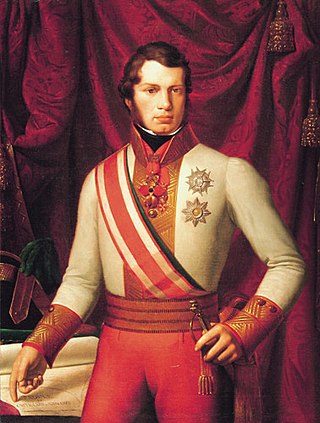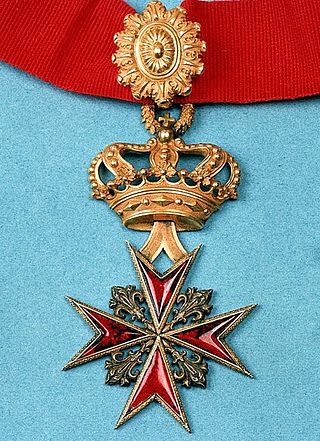
The House of Medici was an Italian banking family and political dynasty that first consolidated power in the Republic of Florence under Cosimo de' Medici, during the first half of the 15th century. The family originated in the Mugello region of Tuscany, and prospered gradually until it was able to fund the Medici Bank. This bank was the largest in Europe during the 15th century and facilitated the Medicis' rise to political power in Florence, although they officially remained citizens rather than monarchs until the 16th century.

Livorno is a port city on the Ligurian Sea on the western coast of the Tuscany region, Italy. It is the capital of the Province of Livorno, having a population of 158,493 residents in December 2017. It is traditionally known in English as Leghorn.

Leopold II was Grand Duke of Tuscany from 1824 to 1859. He married twice; first to Maria Anna of Saxony, and after her death in 1832, to Maria Antonia of the Two-Sicilies. By the latter, he begat his eventual successor, Ferdinand. Leopold was recognised contemporarily as a liberal monarch, authorising the Tuscan Constitution of 1848, and allowing a degree of press freedom.

The Grand Duchy of Tuscany was an Italian monarchy that existed, with interruptions, from 1569 to 1860, replacing the Republic of Florence. The grand duchy's capital was Florence. In the 19th century the population of the Grand Duchy was about 1,815,000 inhabitants.

Cosimo III de' Medici was Grand Duke of Tuscany from 1670 until his death in 1723, the sixth and penultimate from the House of Medici. He reigned from 1670 to 1723, and was the elder son of Grand Duke Ferdinando II. Cosimo's 53-year-long reign, the longest in Tuscan history, was marked by a series of laws that regulated prostitution and May celebrations. His reign also witnessed Tuscany's deterioration to previously unknown economic lows. In 1723, when Cosimo died, he was succeeded by the younger of his two surviving children, Gian Gastone.

Ferdinando I de' Medici, Grand Duke of Tuscany was Grand Duke of Tuscany from 1587 to 1609, having succeeded his older brother Francesco I.

Ferdinand IV, Grand Duke of Tuscany was the last Grand Duke of Tuscany from 1859 to 1860.

The Tuscan Archipelago is a chain of islands between the Ligurian Sea and Tyrrhenian Sea, west of Tuscany, Italy.

Meloria is a rocky skerry, surrounded by a shoal, off the Tuscan coast, in the Ligurian sea, 6.1 kilometres (3.8 mi) north-west of Livorno.

Capraia is an Italian island, the northwesternmost of the seven islands of the Tuscan Archipelago, and the third largest after Elba and Giglio.

The Order of Saint Stephen is a Roman Catholic Tuscan dynastic military order founded in 1561. The order was created by Cosimo I de' Medici, first Grand Duke of Tuscany. The last member of the Medici dynasty to be a leader of the order was Gian Gastone de Medici in 1737. The order was permanently abolished in 1859 by the annexation of Tuscany to the Kingdom of Sardinia. The former Kingdom of Italy and the current Italian Republic also did not recognize the order as a legal entity but tolerates it as a private body.

Don Antonio de' Medici was the only son of Francesco I de' Medici, Grand Duke of Tuscany and his mistress Bianca Cappello. He was a minor figure at the Grand Ducal Medici court.

The Thornton expedition was a 1608 Tuscan expedition under Captain Robert Thornton, an Englishman, sent by Ferdinando I of Tuscany to explore northern Brazil and the Amazon River and prepare for the establishment of a settlement in northern coastal South America, which would serve as a base to export Brazilian wood to Renaissance Italy. The area that Thornton considered as a possible site of a Tuscan colony now lies in modern French Guiana, near Cayenne, which would be colonised by France in 1630. The expedition was the only attempt by an Italian state to colonise the Americas.

Jacopo Inghirami was admiral of the Grand Duchy of Tuscany and marquis of Montevitozzo.

The Hospitaller colonization of the Americas occurred during a 14-year period in the 17th century in which the Knights Hospitaller of Malta, at the time a vassal state of the Kingdom of Sicily, led by the Italian Grand Master Giovanni Paolo Lascaris, possessed four Caribbean islands: Saint Christopher, Saint Martin, Saint Barthélemy, and Saint Croix.

The Livorno Lighthouse is an active lighthouse located at the south entrance of the Port of Livorno in Tuscany on the Ligurian Sea.
The following is a timeline of the history of the city of Livorno in the Tuscany region of Italy.
The following is a timeline of the history of the city of Pisa in the Tuscany region of Italy.

The Villa di Marignolle is a Medici villa in the hills between Galluzzo and Soffiano, in the south-western suburbs of the comune of Florence, in Tuscany in central Italy. It passed into the hands of the Medici family after the Pucci Conspiracy, when it was confiscated from Lorenzo di Piero Ridolfi by Francesco I de' Medici, Grand Duke of Tuscany. Francesco passed it to his illegitimate son Antonio.




















